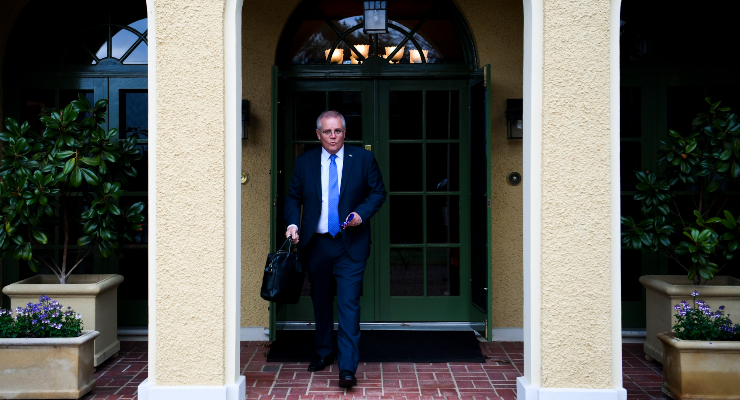
Prime Minister Scott Morrison came out of hotel quarantine and into the fire. State and territory premiers, along with many Australians forced into lockdown, are furious at the government’s bungling of the vaccine rollout and Morrison’s wishy-washy messaging around access to the AstraZeneca vaccine. Half of Australia’s population is living under a lockdown order.
Premiers went into the national cabinet meeting with harsh demands around vaccination goals and international arrival caps, calling for new targets to address the COVID-19 outbreaks.
But the meeting — on the surface, at least — seems to have appeased several premiers. ACT Chief Minister Andrew Barr tweeted that there was an “outbreak of peace and harmony in the federation”, while SA Premier Steven Marshall called the meeting “excellent” and “respectful”.
So what was decided?
A new pathway out
Morrison said Australia will transition from a suppression model to one that will manage COVID as an infectious disease preventing serious illness following mass vaccinations.
Following modelling by the Doherty Institute, Morrison said a four-phase pathway is being modelled. Each phase will be triggered by a percentage of vaccinations reached, with percentages yet to be determined
Phase one — the phase we’re in — will continue to focus on suppression of the virus with reduced arrival caps. The government will also trial with states seven-day home quarantine options for returning vaccinated travellers.
Phase two would lead to higher levels of international arrivals, lockdowns to occur only in extreme circumstances, capped arrivals of student and economic visa holders.
Phase three, the consolidation phase, would lead to managing the virus consistent with other infectious diseases like the flu, and would again increase traveller caps, uncapped arrivals for vaccinated travellers, and allow unrestricted travel between agreed countries.
Phase four is when life returns to normal with uncapped arrivals.
International arrivals to be capped
Following the demands of Queensland Premier Annastacia Palaszczuk, Victorian Premier Dan Andrews, and Marshall, national cabinet agreed to reduce international arrivals, with Andrews and Palaszczuk demanding they stay capped until vaccines are made readily available.
Current international arrivals will be capped by 50% in response to the Delta strain of the virus, though the federal government will increase international repatriations and quarantine returned Australians in Darwin’s Howard Springs facility.
But NSW Premier Gladys Berejiklian, who has been against further caps, said this wouldn’t guarantee outbreaks wouldn’t happen. NSW has been housing most returned travellers in quarantine.
“I am disappointed that every state hasn’t done its fair share but I appreciate and have to respect the decision of the national cabinet,” she said. “My heart goes out to thousands of Australians who have to wait longer to come home.”
WA Premier Mark McGowan pointed to the number of Australians who had flown abroad and returned more than once — many travelling abroad for mining work — as reason for reducing the arrival cap, while Marshall and Palaszczuk said their hotel quarantine placements had reached capacity with interstate travellers returning home.
McGowan also called for extra income support to people who had been affected by lockdowns that did not extend beyond a week; Morrison highlighted the government’s $5.7 billion grant to states and territories to deal with COVID.
“Let there be no suggestion the Commonwealth is not sharing the load here,” he said.
What about vaccines?
While other premiers previously said lockdowns will stop when people are vaccinated, Berejiklian stressed in NSW lockdowns were a last resort.
“Making the vaccination available to people is the key to our freedom, absolutely, and NSW has been extremely vocal about that for many, many months,” she said.
Morrison said once Australia was vaccinated, we would be able to live differently.
Today Australia will hit 8 million vaccine doses administered.
“We get this done, Australia, and you can see what is on the other side,” he said.








Another ScumO announcement, move on. Trust this charlatan? Maybe Jen does but can’t think of anyone else.
A closer look at Scott Morrison’s CV
Morrison’s pre-parliament career casts doubt over his strategic campaigning abilities, his management skills and an apparent tendency towards a lack of transparency.
https://uat.crikey.com.au/2019/02/11/scott-morrison-career/
”When Scott Morrison skipped out the doors of the Property Council of Australia (PCA) in 1995, where he had spent six years cutting his teeth as a spinner, lobbyist and propagandist, he landed in the tourism sector. Specifically, the Tourism Task Force (now the Tourism and Transport Forum) — a lobby group that in many ways mirrored the PCA.”
Red flags waving everywhere.
He was “let go” from two positions, Tourism NZ and Tourism Australia due to some questionable practices in dealing with advertising and media companies.
An audit report covering Scott Morrison’s role in the New Zealand tourism office raises serious concerns over transparency and due process. By Karen Middleton.
Morrison ‘hijacked’ NZ tourism review
https://www.thesaturdaypaper.com.au/news/politics/2018/11/17/morrison-hijacked-nz-tourism-review/15423732007158
New documents show the clearest picture yet of Scott Morrison’s dismissal at Tourism Australia, including scathing correspondence from Fran Bailey. By Karen Middleton.
Fresh documents in Morrison’s sacking.
https://www.thesaturdaypaper.com.au/news/politics/2019/06/08/fresh-documents-morrisons-sacking/15599160008252
Karen Middleton has had her FOI requests for documentation concerning the Tourism Australia sacking refused.
Prime Minister Scott Morrison came out of hotel quarantine and into the fire.
Um. No. He did not. The PM was NOT in hotel quarantine. He was quarantined in The Lodge, the PM’s residence in Canberra. And the plane load of followers (advisers and a couple of journos) who flew to the G7+ and back with him, were also allowed to self-quarantine at home.
This was because the one hotel in the ACT that had been devoted to quarantine had reverted to its normal purposes, so was no longer available as a quarantine facility and nothing else had been constructed.
And what decisions were made about fast tracking special quarantine facilities in every state – just as important as the vaccine roll out but not discussed.
If herd immunity does not work as well as planned, then leak-proof quarantine remains critical, and in any case it will definitely not be 100 years until the next pandemic.
It appears not much though the fact of the matter at issue is the entry of people into Australia and quarantine matters are and always have been the purview of the Federal Government. When on 30 March 1908, the Commonwealth Quarantine service came into operation and took over quarantine stations in every Australian state, as allowed in section 2A of the Quarantine Act 1908.
That is why there were quarantine stations in all major and some minor ports but by the mid 1980s they had all been shut down, none were left available, as far as I am aware, to be able to carry on providing quarantine. So now it is panic stations concerning serious quarantine in Australia.
Now the states have had to commit to such, Victoria fgirst up, now being followed by others, concerning the construction of quarantine facilities, finally Smirko grudgingly agrees to fund construction, as if it was money from his own pocket, not the taxpayers of the CofA , the man who is throwing AUD500 million of taxpayers money at the AWM.
Given quarantine is in the purview of the Federal Government it is clear that at the start of the Covid-19 Pandemic and its arrival in Australia that the buck stopped with the Federal Government, in particular the then Home Affairs Minister Peter Dutton and his Department Secretary Mike Pezzullo.
The Federal Government, with the appalling fiasco of letting infected passengers from cruise ships go unchecked into the community as well as a biosecurity collapse at airports, has made it obvious that there are deficiencies in both Commonwealth emergency management by Australian Border Force and Federal quarantine authorities, this together with some State incompetence.
We now have really obvious Karen, shrieking as oppose to the monotone of Mr Potato Head, aka Voldemort.
Many were quarantined in vacant student accomodation at the ANU.
https://www.abc.net.au/news/2021-06-17/g7-returning-travellers-to-quarantine-at-anu-unilodge/100223546
Marshall saying its respectful….. ‘respectful’ because Marshall rolled over when Morrison asked could he scratch his tummy with home quarantine instead of new quarantine facilities to deal with the deadliest strain of covid yet. Home quarantine…….thats going to work well with the covid deniers & the rest of Morrison’s followers.
Wishing I wasn’t in a Liberal state because we all know that money matters more than people to the present day Liberals.
I don’t know how many readers here also subscribe to The Saturday Paper but Crikey and TSP are to my mind the best independent news sources in Australia. Fearless as well. So I was reading Gadfly today and want to share this as we could all do with a laugh:
Greg Hunt has said slightly more than 1.46 million Australians are now fully vaccinated. Which is very exciting for the 19.14 million Australians eligible for vaccination, until they’re told Barnaby Joyce doesn’t give a shit about them either.
So phase 4 means we can go back to mass immigration, third world population growth, rising unemployment, widespread traffic choking etc etc?
Great incentive to race off and get vaccinated…
It’s sickening. The race to outdo India and China in uncontrolled population growth whose objective is to supply nations with cheap expendable labour and mindless frazzled consumers.
From the Crikey Daily:
” A major booster of Morrison’s “back to the office” speech were his former colleagues at the Property Council, whose members stand to lose out from a major rebalance in the uses of metropolitan buildings.”
Remember Scum cut his teeth for several years among these slime bags and sleaze balls.